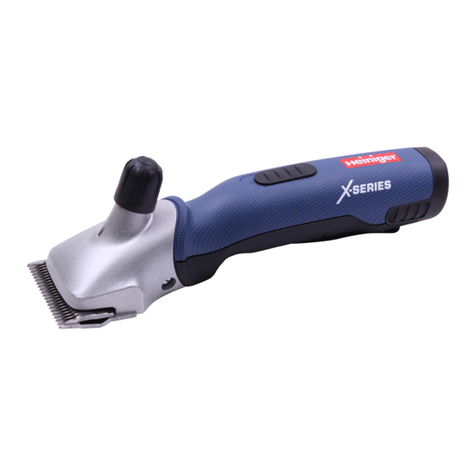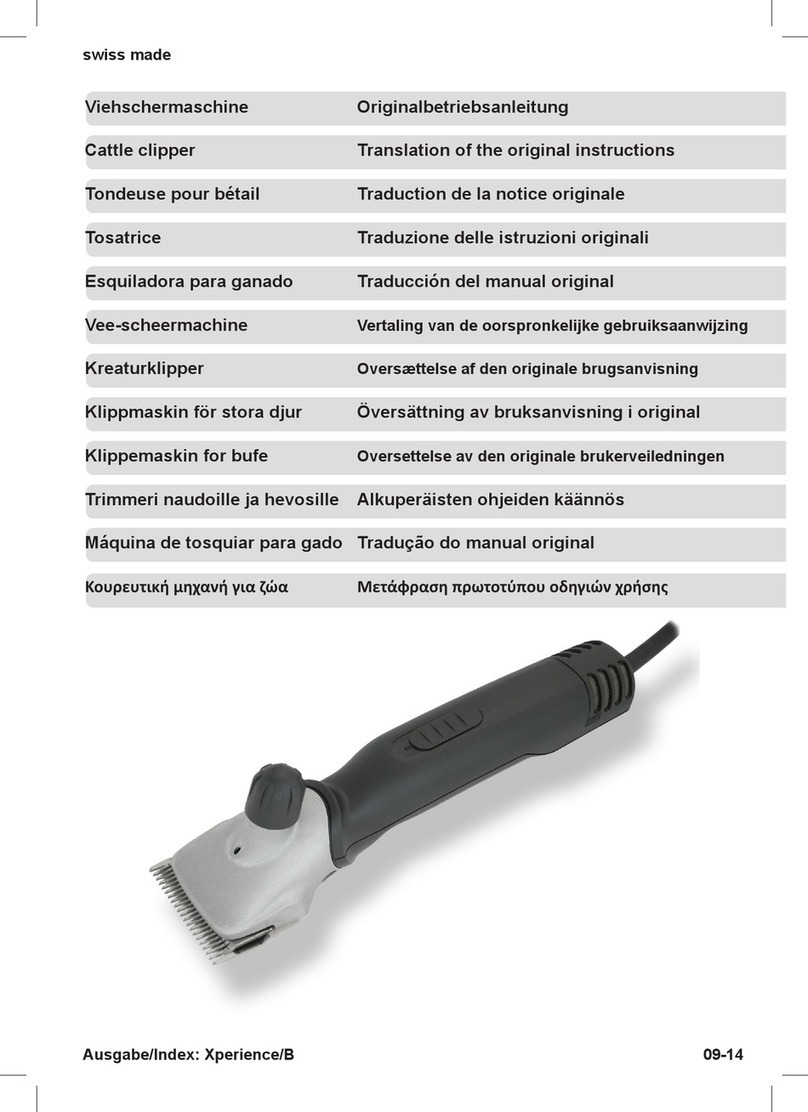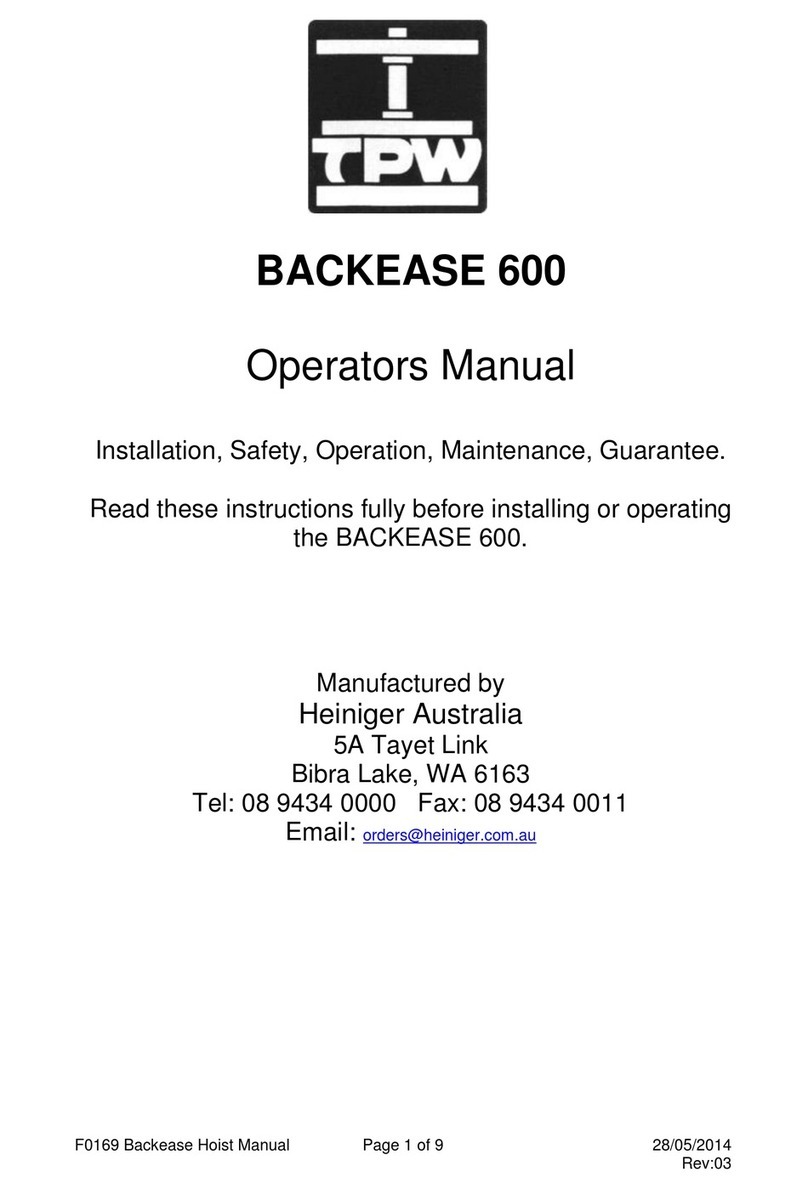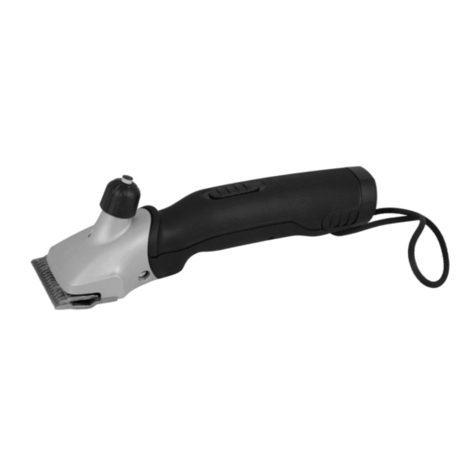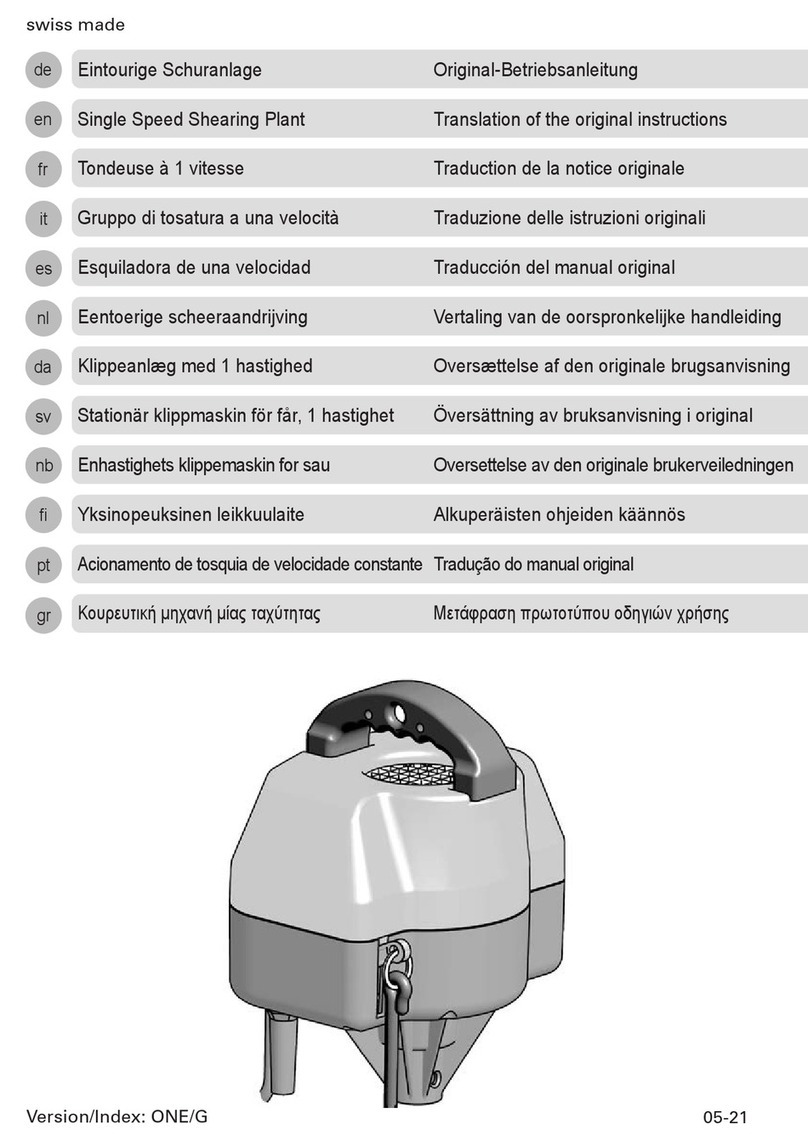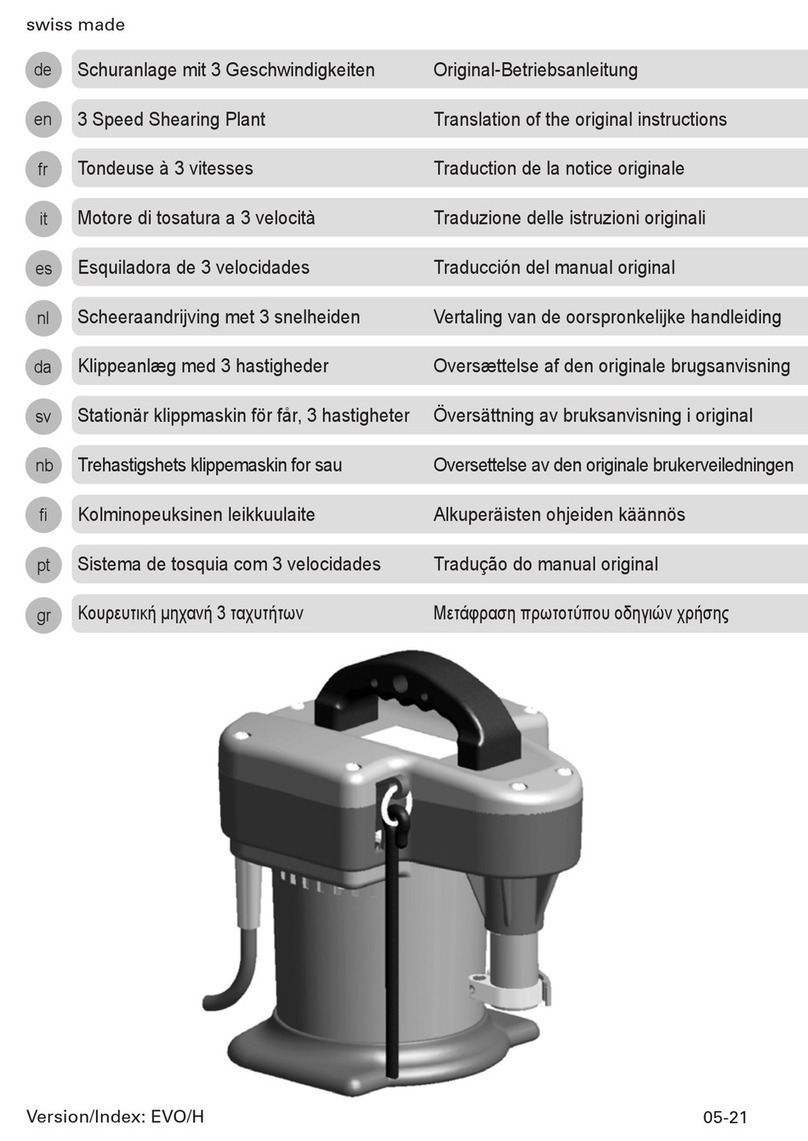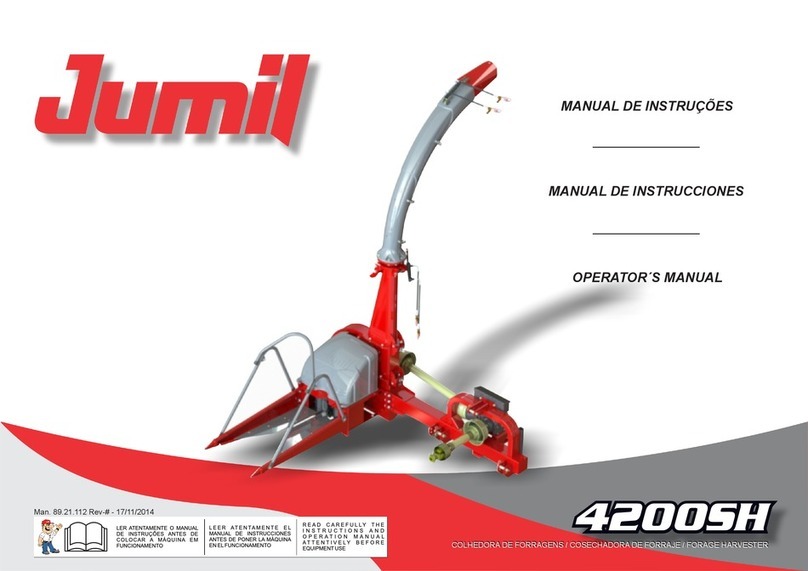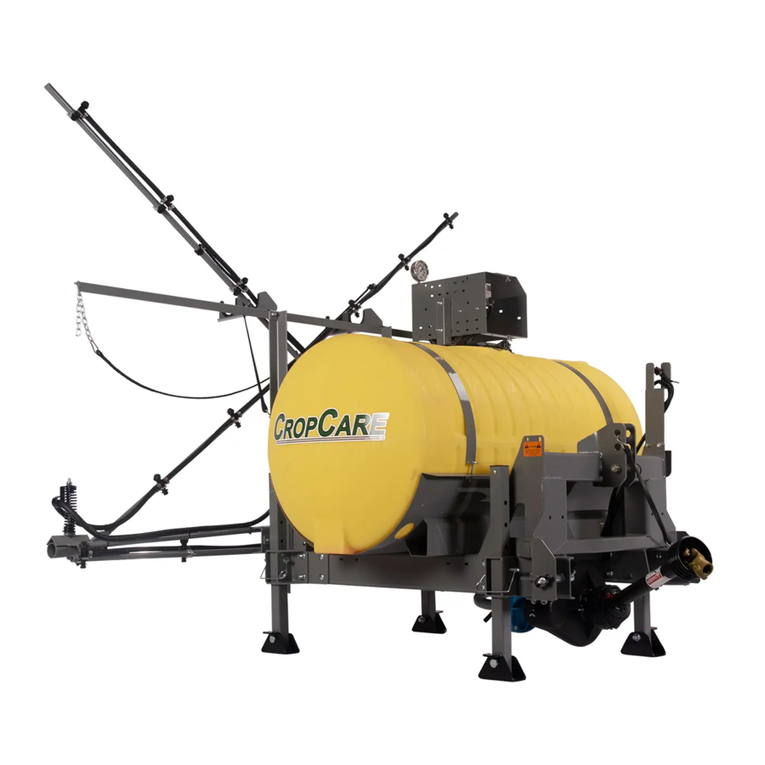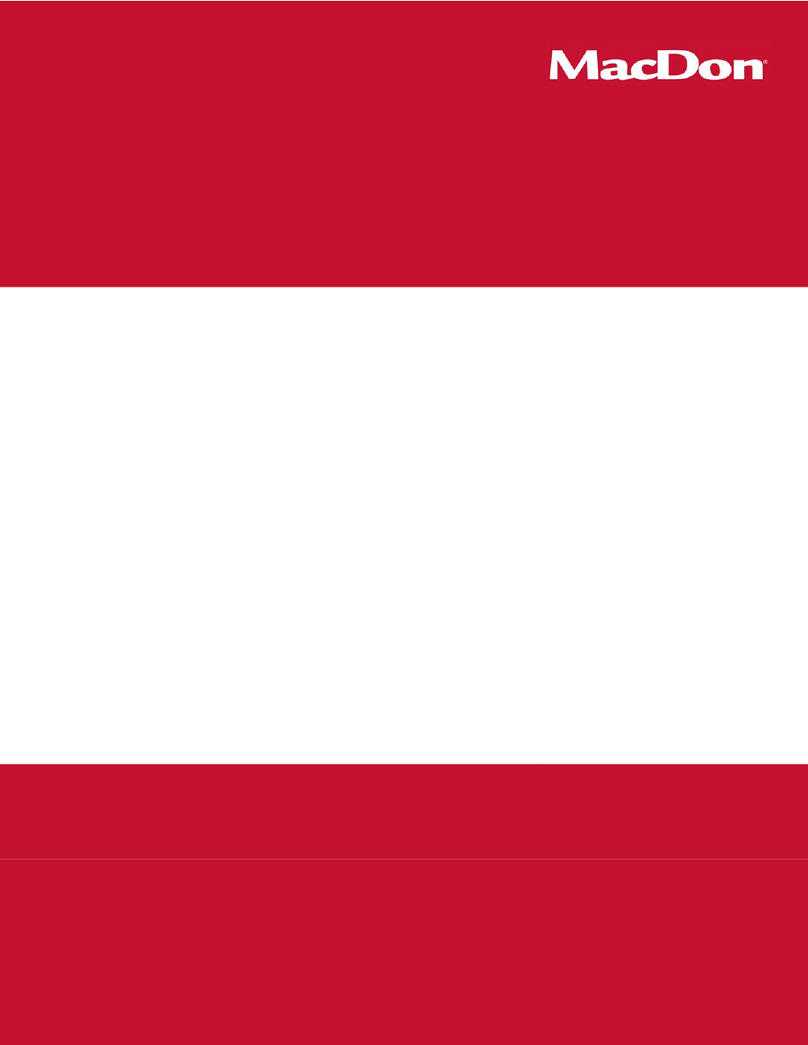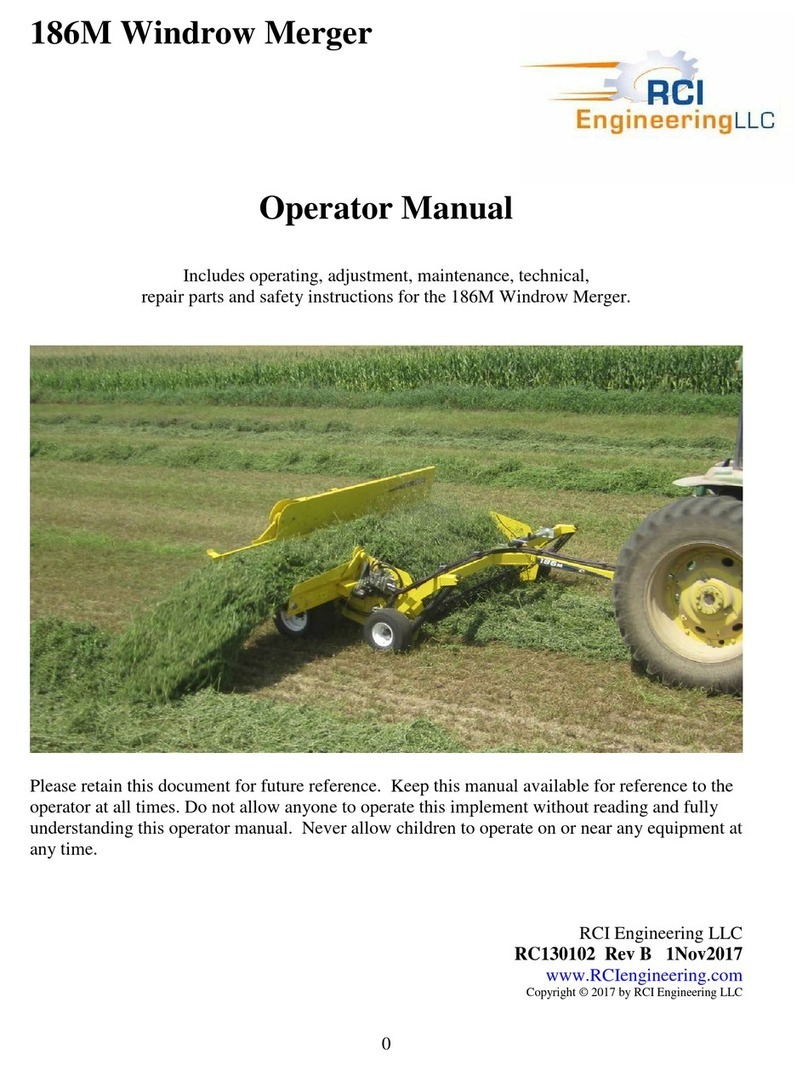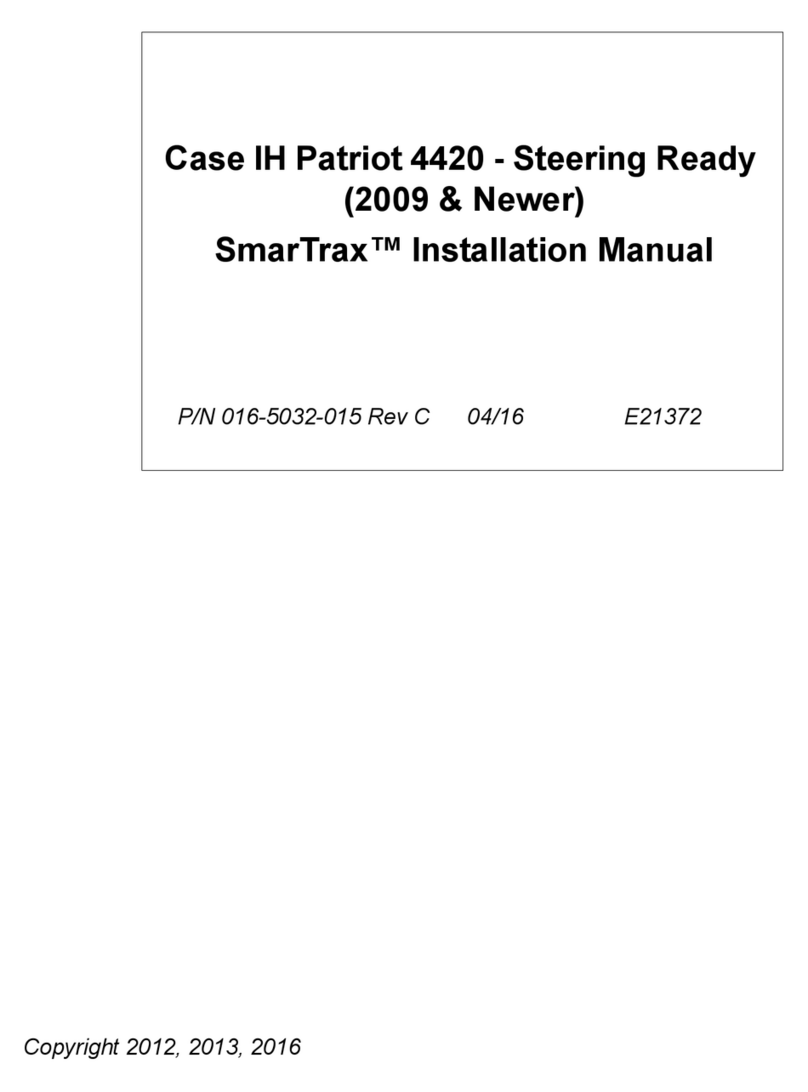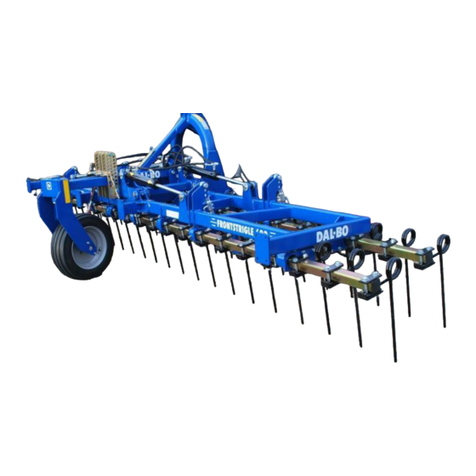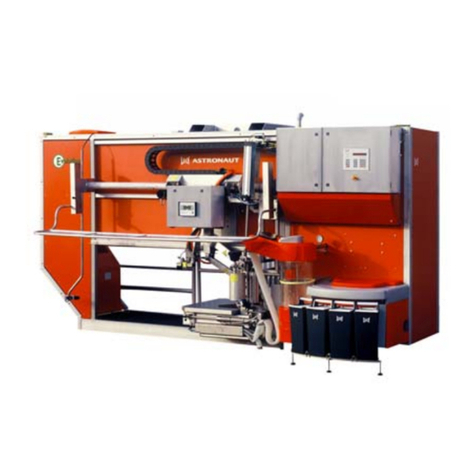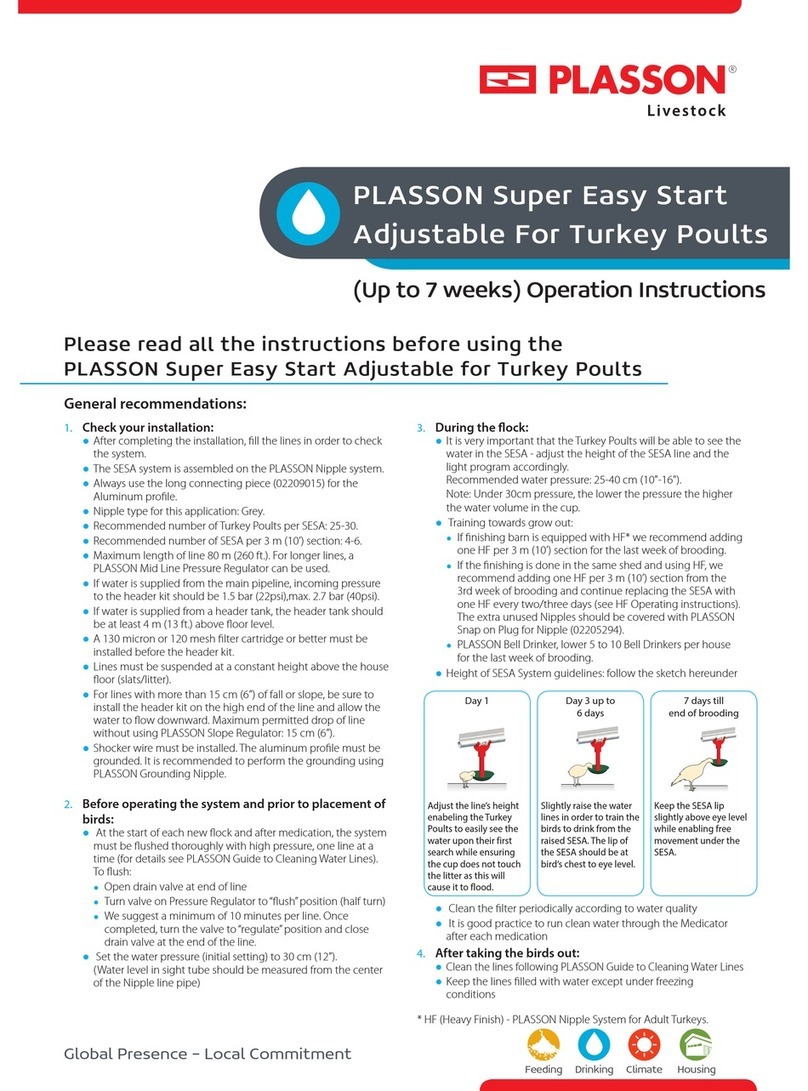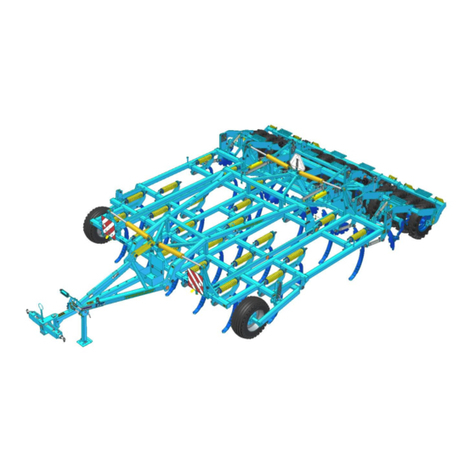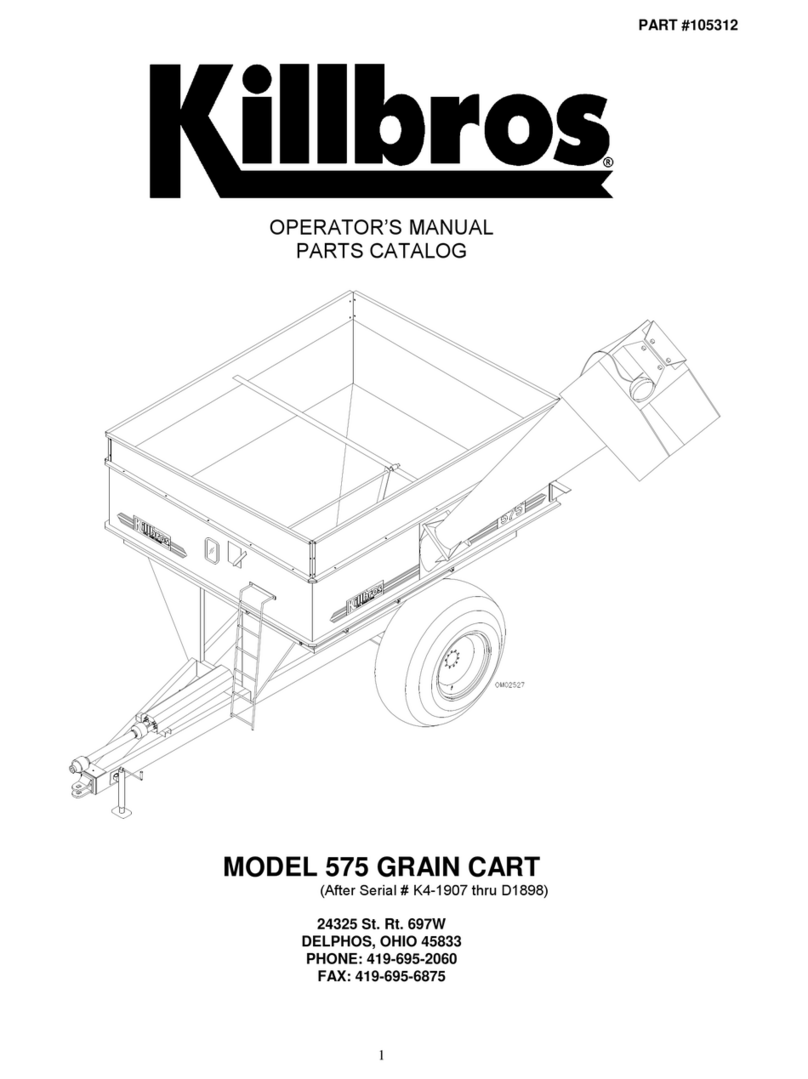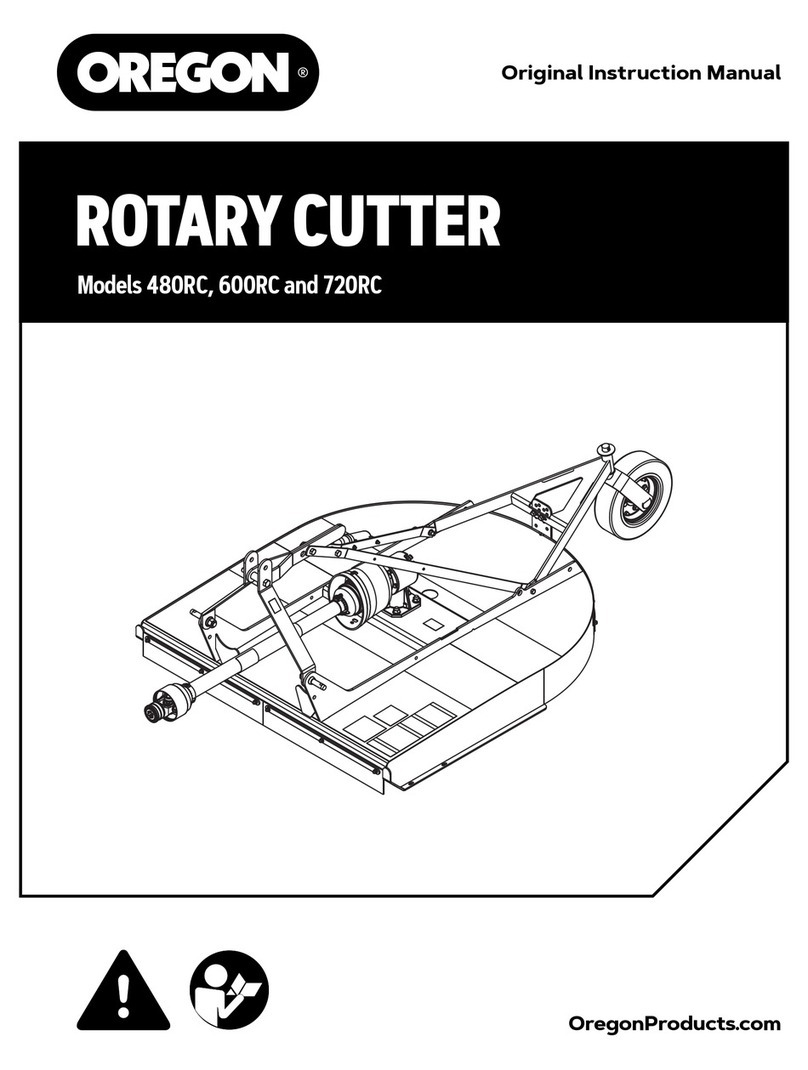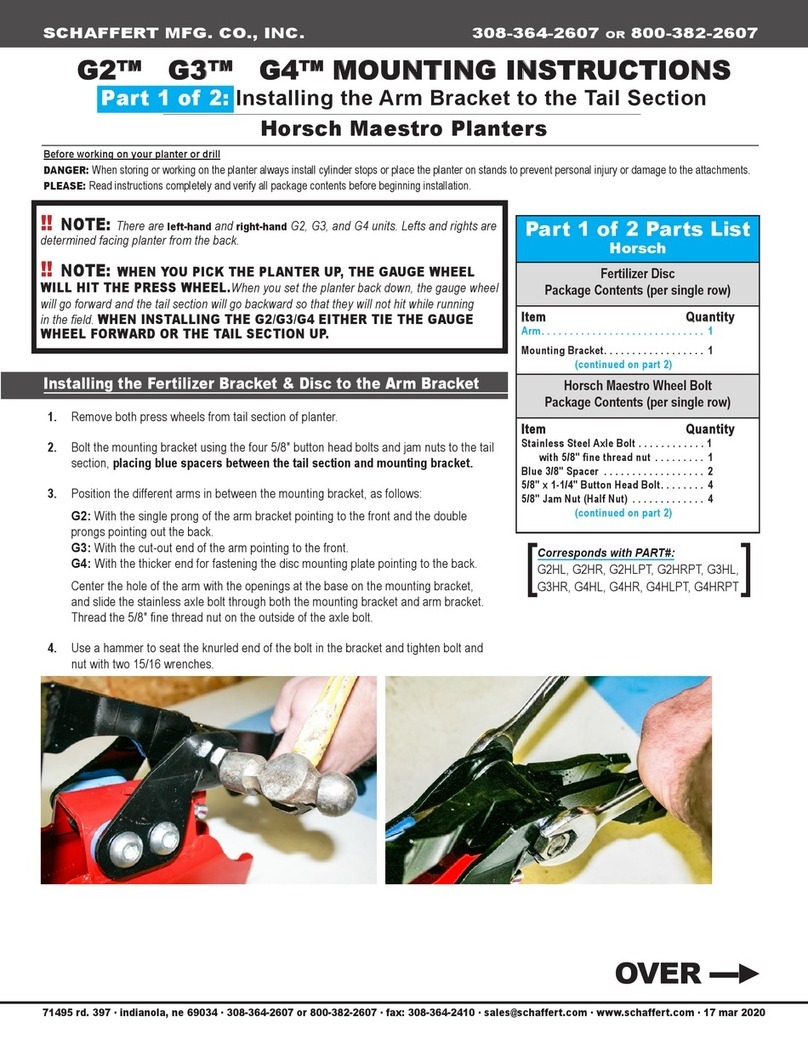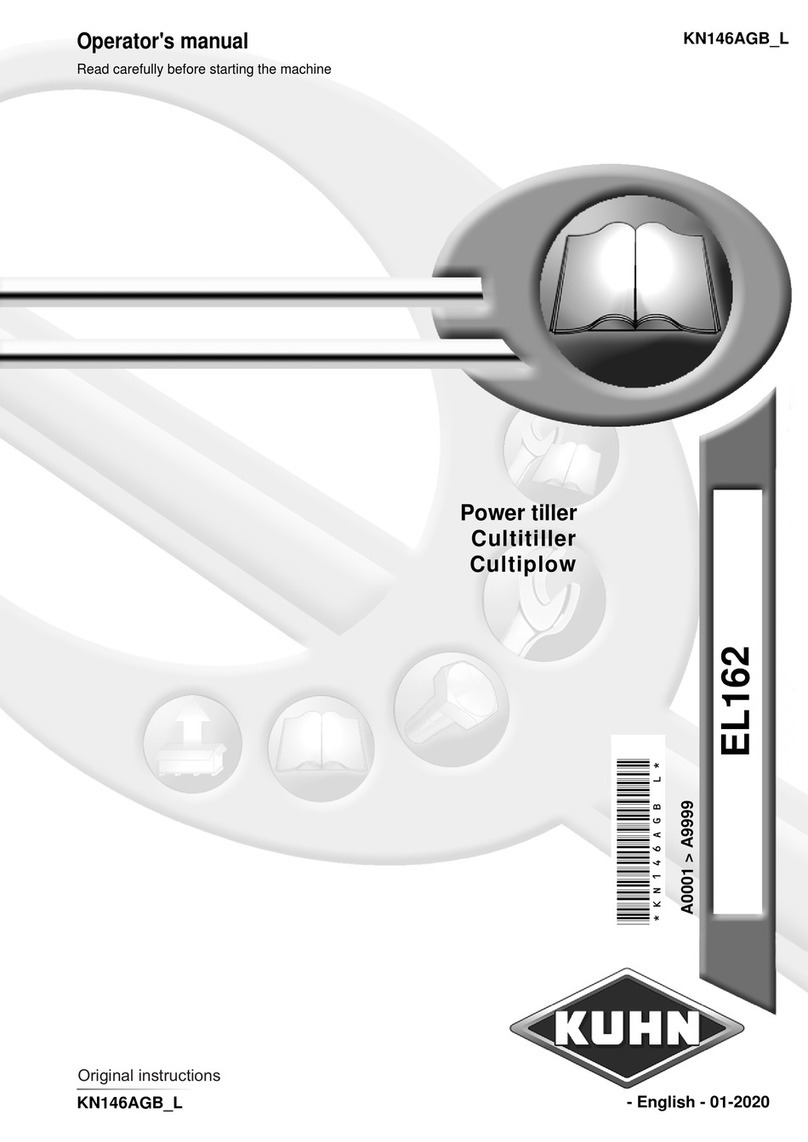Heiniger ICON/I User manual

Exzenterantrieb
Pin-drive
Entraînement à goupille
Accionamiento de pivote
Eksenterdrev
Schneckenantrieb
Worm-drive
Entraînement à vis-sans-fin
Accionamiento por tornillo sinfín
Snekkedrev
swiss made
Ausgabe/Index: ICON/I 10/21
Betriebsanleitung D
Instruction manual GB
Mode d’emploi F
Manual de Instrucciones E
Instruksjonsbok N

2 Instruction manual ICON
Contents
1 Proper Use
1.1 Overall View / Controls
1.2 Intended Use
1.3 Technical Data
1.4 Equipment Items
2 Safety Regulations
2.1 Introduction
2.2 Symbols and Warning Signs
2.3 Proper Use
2.4 Safety Principles
2.4.1 Drive Connections
2.4.2 Servicing and Checking Requirements
2.4.3 Noise Emission / Personal Protective Equipment
2.4.4 Other Dangers
2.5 Essential Operator Skills
3 Putting into Operation
3.1 Controls and Operation Notes
3.2 Shearing Adjustment using theTension Nut
3.3 Lubrication
4 Servicing
4.1 Cleaning
4.2 Fitting the Shearing Blade
4.3 Resharpening the Shearing Blades
4.4 Storing
5 Maintenance & Repairs
5.1 Introduction
5.2 Maintenance
5.3 Repair Kits
5.4 Malfunction List
5.5 How to
6 Environmental Protection and Disposal
6.1 Introduction
6.2 Material Categories
7 Contact Addresses
Illustrations: at the end of the instructions

Instruction manual ICON 3
Pos Description Total
1 Barrel ICON 1x
2 Centre post 1x
3 Locknut 1x
4 Comb screw 2x
5 Crankshaft 1x
6 Ball 1x
7 Safety screw 1x
8 Oil hole cap 1x
9 Tension nut bushing screw 1x
10 Retaining ring 1x
11 Tension pin 1x
12 Tension sleeve upper 1x
13 Tension nut 1x
14 Distance washer 1x
15 Ball bearing 1x
16 Spring washer 1x
17 Gliding bush 1x
18 Retaining ring JV 27 x 1.2 Typ J 1x
19 Seal 1x
20 Back joint cover 1x
1 Proper Use
1.1 Overall View / Controls
Component Names
Illustr. 0
Pos Description Total
21 Back joint cap 2x
22 Back joint spring 1x
23 Inner back joint 1x
24 Outer back joint 1x
25 Ball bearing 2x
26 Cog Z14 2x
27 Drive shaft ICON PIN-Drive (1x)
28 Tapered pin Ø3 x 12 mm 1x
29 Drive shaft ICON WORM-drive 1x
30 Chicken feet retaining spring 1x
31 Pan-head screw M4 x 5 1x
32 Centre post cup 1x
33 Fork body 1x
34 Tension pin retaining spring 1x
35 Tension pin cup 1x
36 Chicken feet L+R (pair) 1x
37 Fork body assembly complete (1x)
38 Ferrule Ø22 x 180 mm solid-drive (1x)
38 Ferrule Ø22 x 160 mm flex-drive (1x)

4 Instruction manual ICON
1.2 Intended Use
The (machine) is intended exclusively for use on sheep and goats, as well as llamas, alpacas
and other members of the camel family.
Other uses, in particular using the machine on people, are expressly prohibited.
1.3Technical Data
Designation:
Model:
RPMmax:
Dimensions (B/H/L):
Mechanical Shearing Handpiece
“ICON“
3500 U/Min.
approx. 65mm x 95mm x 320mm
Max. AmbientTemperature: 0°C - 40°C
Max. Air Humidity: 10% - 90% (relative)
Noise Emission (LpA): >70 dB(A) (EN 50144-1/02.96 & EN ISO 3744/11.95)
Acceleration (ahw): > 2,5 m/sec2(EN 28662-1/01.93)
We reserve the right to adopt technical changes and improvements.

Instruction manual ICON 5
1.4 Equipment Items
1 Shearing Handpiece (machine)
1 Special Screwdriver
1 Operating Instructions
Options:
Various shearing combs and cutters
Special comb cleaning brush
Special lubricating oil
Post Guide
2 Safety Regulations
2.1 Introduction
This Section describes the mandatory safety regulations which must be observed when using
the machine.
All persons undertaking work on or with the machine have an obligation to read the opera-
tion instructions.
The operating instructions must be kept safely and accessible at all times.
2.2 Symbols and Warning Signs
Various symbols are used in the operating instructions.They refer to potential dangers or point
to technical information, the non-observance of which will lead to personal injury, damage to
objects or inefficient operation.
Danger Symbols
Warning
indicates a potentially dangerous situation. If preventive action is not taken, death or very
serious injury could result.
Caution
indicates a potentially dangerous situation. If preventive action is not taken, the consequences
could be slight or minor injuries.

6 Instruction manual ICON
Information Symbols
Note
Note, non-compliance with which can lead to operating malfunctions or damage.
Pictorial Note
This symbol, together with its number, refers to the relevant illustration at the end of the
instructions.
2.3 Proper Use
The use which the machine is intended for, is described in Section 1.2.
The following applies to safe operation:
The details at Section 1.3, “Technical Data“, count as mandatory operating limits and ratings.
Shearing other animals, in particular dangerous animals such as beasts of prey and the like,
counts as misuse.This could lead to circumstances dangerous to life and limb.
2.4 Safety Principles
2.4.1 Drive Connections
Only connect the machine up to undamaged, inspected shearing drive shafts & motors
(shearing plants). Damaged shafts or motors can cause lock up which can cause serious injury.
Defective installations can cause an electric shock or a short circuit.
Make sure to use the correct type of drive coupling, i.e. only connect a worm-drive type
handpiece to a worm-drive type shearing drive (Illustration 1, Item 1) and a pin-drive handpiece
to a pin-drive shearing drive (Illustration 1, Item 2). Do not mix the two system as it can cause
malfunction and unexpected behaviour of the whole system.
Servicing and cleaning must only be carried out when the machine is removed from the drive
(shearing plants).
Never leave the machine unsupervised when connected to a shearing drive. Keep children
away from the working area and store the machine out of their reach.
2.4.2 Servicing and Checking Requirements
Only operate the machine if it is undamaged and in a proper condition. Any defects to the
housing (barrel) or the drive shaft connection should be rectified by a repair or service agent.
2.4.3 Noise Emission / Personal Protective Equipment
Wear Ear Protectors !
Typical sound emission when working are >70 dB(A). We recommend that ear protectors
should always be worn when working.
Illustr. 1

Instruction manual ICON 7
Wear Protective Goggles and Gloves !
For your personal protection we recommend that you wear protective goggles and gloves.
Personal protective equipment is to be provided by the operator.
2.4.4 Other Dangers
Should evidence of dangers or potential dangers, not directly related to the shearing of
animals, occur during operation, we would ask you to inform us. This also applies to dange-
rous technical deficiencies.
2.5 Essential Operator Skills
Operating the machine safely makes only small demands of the operator. However, it is essen-
tial that they are observed and carried out.
• Theoperatormustbeexperiencedinhandlingtheanimalstobeshorn.
• Theoperatormusthavereadandunderstoodtheinstructionsorhavebeeninstructedbyan
expert in the machine’s use and have had the potential dangers explained.
Children are not permitted to operate the machine.
3 Putting into Operation
3.1 Controls and Operation Notes
There are dangers inherent in the improper use of mechanical equipment, especially stock-
breeding equipment! Therefore, before using the machine, you should observe the following
accident-prevention measures:
• Observetheadvisorynoteslistedat2.4.1(driveconnections).
• Avoidallcontactwiththemovingshearingblades(comb&cutter).
• Evenwhentheshearingdrive(shearingplant)isswitchedoff,donothandletheareaof
the shearing blades as long as the machine is connected to the shearing drive. Always
disconnect the machine from the shearing drive first when working on the shearing blades/
machine.
• Nevershearwetanimals.Wetwoolmayenterthemachinebody(barrel)andcauselock
up.
• Generally,neverplungetheclipperandclipperheadintoliquidssuchaswater,soapywater,
diesel, petrol, etc.This may cause serious injury to mechanics and motor.
• Neverputyourhandpieceinavice,itwilldisfigurethebarrelandthebackendwillbecome
tight.
• Neverattempttointerchangepartsfromanothermodel/typeorbrandofhandpiece.
• Onlyuseoriginalshearingblades(combs&cutters;Illustration5).Donotusedamaged
shearing blades with blunt, missing or broken off teeth. Only work using sharp shearing
Illustr. 5

8 Instruction manual ICON
blades, ground according to advisory notes listed at 4.3 (Resharpening the Shearing Blades)
• ookingoutforforeignbodies(wire,wood,etc.)inthefleeceandremovethembefore
beginning to shear.
• Wearsuitableworkclothes.Donotwearanyloosefittingclothingoritemsofewellery
which could get caught up in moving machine parts. We would recommend in the strongest
terms that protective goggles and ear protectors are worn.
• Neverinsertanyobectintoanyofthemachinesapertures
• Noisefromthemachinecanworryanimals.onsiderableinurycanbecausedasaresultof
being kicked by an animal or being crushed by its body weight.
• Animalsshouldonlybeshornifunauthorisedpersonshavebeenexcludedfromthe
shearing area.
• Onlyshearinwellventilatedspaces(dust)andnevernearobectsorgaseslikelyto
explode.
• Werecommendyouuseacombfornolongerthananhourandacutterfornolongerthan
15 minutes before you change them for a sharp comb and cutter
These Safety notes must be complied with in all cases.
3.2 Shearing Adjustment using the Tension Nut
Before putting into operation, make adjustments as follows:
Before Shearing:
With the machine disconnected from the shearing drive: ensure that theYoke’s carrier (chicken
feet) cone pins mesh precisely into the positioning holes in the cutter (Illustration 2, Item 2).
Tighten the tension nut until resistance is first noticeable (Illustration 2, Item 1).Then tighten
the tension nut a further 1⁄4 turn.
Connect the handpiece to the shearing drive (observe advisory notes listed at 2.4.1) and start
operating the shearing drive motor. Slacken off the tension nut (Illustration 3) until the shearing
blades exert almost no more contact pressure (noise level rises).
Caution! If the tension is slackened off too much, the cutter can fly off causing injury.
Now tighten the tension nut slowly until the noise level becomes muffled and some resistance
is detectable as you tighten the tension nut. The pressure should now be correctly set. Begin
shearing. If it still does not cut properly, you will have to add a little more tension.
During Shearing
Provided the shearing blades are properly sharpened (ground) the shearing system works with
much less pressure having to be applied than with traditional shearing machines. Care should
be taken, therefore, to ensure that the blade tension is not set too high. Too high tension
causes more friction and reduces the life expectancy of the shearing handpiece as well as the
shearing blades. Slightly adjust the blade tension from time to time during shearing (max. 1⁄4
turn).
Hair may collect between the shearing blades, if the tension nut is insufficiently tightened at
the start of shearing. This will have an adverse effect on further shearing progress or make it
quite impossible. If this happens, the shearing blades must be disassembled, cleaned, oiled
and re-fitted as described at 4.2 (Fitting the Shearing Blades)
Illustr. 2, 3

Instruction manual ICON 9
3.3 Lubrication
Before and During Shearing
A thin layer of oil on the cutter and the comb plate (Illustration 4, Item 4) is essential for good
shearing results and so as to increase the life of the machine and its shearing blades. All other
moving parts must also be well oiled (Illustration 4, Item 3) .
Only use our special clipper oil or a paraffin oil meeting the ISO VG 15 specification. This oil is
non-toxic and produces no irritation on contact with the skin or the mucous membranes. This
paraffin oil degrades to some 20% after 21 days (CEC-L-33-T-82).
You cannot over oil ! The more often you oil, the cooler it will run and the longer it will last.
Especially if you are shearing llamas, alpacas or other camelides, even more frequent oiling of
comb and cutter may be needed.
Always oil the machine before use, and at least at every cutter change.
Oil the following parts
• eforeyouassemblethebladestothehandpieceturnthehandpieceupsidedown
(Illustration 4,Item 1) and run oil into the centre post cup through the hole illustrated.
• Oilthetensionsleeveortopoftensionpin(Illustration4,Item2).
• Turnitbackoverandoiltensionpincup(Illustration4,Item).
• Wetthecogswithoil.
• Oildowntheferruletolubricatetheouterbackhalfointandthepinorwormdrive.
• Oiltheballthroughtheholeinthetopofthebarrel.
• Oilthecutterandcombwhenset(Illustration4,Item4).
Do not put oil or grease between the tension nut and the tension sleeve as this will cause loss
of tension.
Grease
Once a week remove, clean and regrease the following parts:
• okescarrier(chickenfeet)emovethecombandcutter,turntheyokescarrierat
degrees to the fork and pull them out using a pair of pliers. Clean them and the locating
holes in the fork and apply a small amount of grease on the yoke’s carrier shank and replace
it making sure they twist freely in the fork when replaced. If they don’t, remove and clean
more thoroughly.
• ackointapsemovethebackointspring,takeoffthecapsandcleanoutanyold
grease and dirt. Apply a small amount of grease in the cap and reassemble.
• Tensionleeveemovethetensionnut,tensionsleeveandtensionpin.emoveallthe
grease from inside the tension sleeve and from the tension pin. Apply a good amount of
grease to the inside of the tension sleeve and replace it, remember to remove all grease
from the outside of the tension sleeve before replacing the tension nut.
Bearings
The shearing handpiece is fitted with bearings which are sealed and will never need oiling or
greasing.
Illustr. 4

10 Instruction manual ICON
4 Servicing
Before starting any servicing work, disconnect the handpiece from the shearing drive.
4.1 Cleaning
After shearing, remove all oil from the machine by rubbing it down with a dry cloth and
carefully clean the outside of the shearing handpiece and the shearing blades with a dry brush.
Then oil the parts to prevent rusting. Even the smallest rust spots on the blades can adversely
affect shearing or make it completely impossible.
4.2 Fitting the Shearing Blades
A pair of shearing blades consist of a comb plate (Illustration 5, Item 2) and an cutter
(Illustration 5, Item 1). When fitting the blades care should be taken to ensure that the correct
surfaces come to rest against each other.The blades are fitted as follows:
Loosen the tension nut (Illustration 3) and place the machine on a hard surface so that the
comb blade fixing screws lie uppermost. Slacken off the screws (Illustration 6) and remove
both the old shearing blades.
Ensure that the new shearing blades are clean. Particular care should be taken to ensure that
thegroundsurfacearefreeofdirt;ifnot,evennewlygroundshearingbladeswillnotshear
satisfactorily.
Place the new cutter in the yoke’s carrier (chicken feet) cones (Illustration 7 and 2, Item 2) and
push the new comb plate between the loosened screws (Illustration 8). Now tighten the comb
blade fixing screws until you can just move the new comb plate sideways by hand.
Now turn the machine over so that the tension nut is against uppermost.
What is now important is that you rest the blades against each other in such a way that the
ground surface of the comb plate projects approx. 1.5 - 2.0 mm beyond the tips of the cutter
(Illustration 9) at the same time all sharp corners of the cutter indicated at (c) must be within
the indicated area (b)
Once you have adjusted the shearing blades, set the position of the comb plate and tighten up
the comb blade fixing screws.
Check that the shearing blades have been correctly fitted and that the pressure yoke’s carrier
(chicken feet) cones (Illustration 2, Item 2) are situated in the holes provided in the cutter. Now
tighten up the tension nut until the cutter is pressed against the comb plate and you can feel
a slight resistance.
4.3 Resharpening the Shearing Blades
Only work with sharp shearing blades. Replace blunt blades or those with missing teeth.
Proper resharpening can only be done with a special shearing blade grinder and by a trained
technician or experienced Shearer. For correct shearing blade grinding technique, please
follow the instructions which comes with every Heiniger shearing blade grinder.
Illustr. 5, 3, 6
Illustr. 2, 7, 8
Illustr. 9, 2

Instruction manual ICON 11
4.4 Storing
Only store the shearing handpiece in a dry place. Do not connect it to a shearing drive if you
suspect any liquid has got into it.There is then the risk of a corroded and therefore seized drive
mechanism which, if you try to run the handpiece, can cause injury.
Make it a habit to store the machine between use, store it well-cleaned, oiled and with tension
slackened off, in a clean, dry place, out of the reach of children.
5 Maintenance & Repairs
This product has been developed and assembled using the best individual components
available. It is designed to give longevity and high performance. If spare parts are used during
the life of this product, please ensure that they are genuine Heiniger parts. Failure to use
genuine Heiniger spares may reduce the performance of this precision engineered product and
will void any warranty claim.
5.1 Introduction
Always contact an authorised service centre if you are unsure how to rectify the problem and in
the event of malfunctions not contained in these instructions
Details of authorised service centres are to be found at the end in the „7 Contact Addresses“
section.
5.2 Maintenance
It is impossible for us to say how often you should replace parts, as wear factors vary from
country to country and shed to shed, however, the components are manufactured from the
highest quality metals that will enhance the life expectancy of your handpiece.
5.3 Repair Kits
Three repair kits are available. It is advisable to fit complete repair kits and not replace indivi-
dual parts when carrying out a service, this will ensure the smooth and true running of your
shearing handpiece.
Repair kits consists of the following parts:
Illustr. 23
•tensionsleeve
•tensionpin
• tensionpincup
• tensionpinretaining
spring
• centrepost
• centrepostcup
•tensionsleeve
•tensionpin
•tensionpincup
•tensionpinretaining
spring
•centrepost
•centrepostcup
•centrepostlocknut
•2xcogs
•ball
•Frontbearing
•Backhalfjointbearing
•seal
•wavewasher
•circlip
•distancewasher
Short Replacement Kit Bearing Replacement KitLong Replacement Kit

12 Instruction manual ICON
Firstlfindoutwhereexactl
onthehandpiecetheheatis
coingfroetitcooldown
tartagainandatteptto
locatetheoriginalheatsource
andpiecerunshot
stheresandandorgritinside
thefrontofthebarrel
ithcobandcutterin
placeandafirgriponour
handpieceputourthubover
theoilholeandfillthebarrel
withoilfrothefrontwhilethe
handpieceisrunninghilst
stillrunningturnitupsidedown
anddraintheoilout
heckthatourcoband
cutteraresharpandnotover
tensioned.
esharpenhenuseless
tension.
entreposthasdirtbetweenit
andthecentrepostcup
eatonthuborforefinger eovethecutterturnthe
handpieceupsidedownandoil
thecentrepostcupliberall
opoftensionpinandinside
tensionsleeve
Hot tension nut. Firstcleanoutthetension
sleeveandcleanthetension
pinegreaseandtragain
aveouputtheballonthe
wrongwaaroundheflat
sidegoestothecrankhead
otonringfingeroriddleof
handpiece
eoveandturnaround
oolbuildupbetweenball
andcrankheadaroundthe
crankpin
eovewool
opofthetensionpiniswor eplacetensionpinandsleeve
entrepostcuparewell
worm.
Fitshortrepairkit
eatfrofrontregionin
general.
MALFUNCTION RECTIFICATIONCAUSE
5.4 Malfunction List
Actions to be taken to rectify malfunctions are indicated in the „Rectification“ column of the malfunction
list. Those rectification notes printed on a dark background may only be carried out by a trained person or
an authorised service centre.
selesstensionorresharpen
comb and cutter.
Frontbearingsisrunninghot
probablcausedbtoouch
tension or blunt comb and
cutter.
eplacebearingsasthecrankgotalotof
oveentupanddowninside
thebearing

Instruction manual ICON 13
Oilmoreregularly.Cogsmaybedry.Hotonlittlefingeroratthe
backofthehandpiece.
Cogsmaybeworn.
causingthecogstorununtrue.
Resharpencombandcutter.
Backbearingrunninghotdue
totoomuchtension,comband
cutter are blunt.
Replacebearings. Bearingfailure.
Lossoftensionbetweencomb
and cutter.
Cleanthesleeveandinsidethe
tension nut.
Greaseoroilbetweenthe
tensionsleeveandtensionnut.
Replacetensionretaining
spring.Makesuretheend
withoutthe90degreebend
pointsintheclockwisedirec-
tion.
Worn or no tension retaining
spring.
Replaceallthreeparts. Worntensionpin,sleeveand
cup.
Removeit,cleanitandthe
threadinsidethebarrel.
Hasyourtensionnutbushing
screwcomeloose?
Lossofcut. Firstlyaskothershearersin
theshediftheyhavethesame
problem.Iftheydo,maybeit’s
notyourhandpiece.
Checkyourcuttersareground
flatwithaburronthetips.
Ittakes3goodgrindsto
reshapeyourcombstoanew
positiononthediscorwhen
using a new disc.
haveyouchangedgrinder?
Grind down comb screw
thread.
Areyouusingverythincombs
andtheforkishittingthecomb
screws?
Resetwithpostguideorresetto
originalclockmark.
Hasyourpostshifted.
Fitshortrepairkit.Wornparts.
Tension-pin,-cupand-sleeve.
Replacecombscrews.Crackedcombscrews(too
muchhealgrindoncombs).
Sharpenyourgeartwiceto
makesure.
Checkyourcombandcutters
aresharp.
MALFUNCTION RECTIFICATIONCAUSE
Replacecapsandbackjoint
Sidewaysmovementbetween
innerandouterbackhalfjoints spring.
.
Always replace special cogs in pairs.
It is essential to use identical special
cogs.

14 Instruction manual ICON
sethickercuttersorfilea
sallaountoffourpins
reouusingthincutterwith
chickenfeetpinsreaching
throughthecutterandhitting
thecob
eoveandcleanthoroughloolorgreasebuildupunder
thebackjointcover
ightbackend
irtbetweentheinnerback
halfjointandthebush
aveouputourbarrelina
vice
Buanewone
eovethebackjointclean
thebackjointandinsidethe
bushwitharagoistwith
solventeplacethesealreoil
and reassemble.
eplacewithnewcirclip
eplacewithnewcirclip
aveoureassebledthe
handpieceusinganoldcirclip
aveouovercopressed
circlipwhenfitting
esetandtightenasourpostcoeloose
Grind down comb screw
thread
reouusingthincobs
andtheforkishittingthe
cobscrews
fcracksarepresentreplaceit
iediatel
aveouhadacoband
cutterlockupleanand
checkforkthoroughlfor
cracks
eplacecobscrewsrackedcobscrewsfro
toouchhealgrind
eplacechickenfeetheckchickenfeetpinsarenot
overworwherethefitinto
cutter.
Firstllocatewherethe
problesisinourhandpiece
alsotritonanothershearing
drivetoseeiftheprobleis
stillpresent
bnoralvibrationorruns
rough
heckchickenfeetareagood
fitinsideforkbod
eplacechickenfeet
sourcobtightonthecob
bed
ightencobsscrews
ibrationfrofront
hecktheballisagoodfiton
thecrankshaft
ibrationfroiddle eplaceball
MALFUNCTION RECTIFICATIONCAUSE

Instruction manual ICON 15
eplaceforkbod
eplacebearing
hecktheballraceinthefork
issooth
heckthefrontbearingfor
wear.
eplacecapsandbackjoint
spring
heckouhavenooveent
betweenthebackhalfjoints
heckourcogsareingood
condition.
hecktheforkisnothittingthe
crankshaftheadbecausethe
postisnotcorrectlset
esetpost
hecktheferruleisnotslopp
insidetheshorttube
hangetheshorttubeandthe
ferrule
asourhandpiecelockedup
andbentthecrankshaft eplacethecrankshaft
ibrationfrobackend
heckthebearingsintheinner eplaceifwor
andouterbackhalfjoints
eplacethebushfirstifitisstill
sloppreplacetheinnerback
halfjointalwasreplacethe
seal
hecktheinnerbackhalfjoint
isagoodfitinsidethebush
withnosidewasoveent
MALFUNCTION RECTIFICATIONCAUSE
Always replace special cogs in pairs.
It is essential to use identical special
cogs.

16 Instruction manual ICON
5.5 How to
Note: This Section is for experts only. Do not follow this instructions if you are not a trained
technician or experienced Shearer with good knowledge of mechanics. Wrong or unprofessi-
onal repair and maintenance of the handpiece can cause malfunctions which lead to serious
injury, damage and/or reduced life expectancy of your shearing handpiece. Warranty will be
void if unprofessional repair or maintenance has been carried out.
Remove Fork
Unscrew tension nut and remove tension sleeve and tension pin, unscrew fork safety screw.
Fork may now be removed. It is not necessary to remove the centre post when removing the
fork. Reassemble in the opposite order.
Fitting a new ball
Remove fork and ball, place new ball on the crank pin using a piece of wire or a pencil with the
flat side of the ball pointing to the crankhead or rear of the handpiece.
Replacing the tension pin cup
Remove fork, punch out the old tension pin cup. Place the new tension pin retaining spring on
to the tension pin cup before replacing it into the fork, tap the cup into the fork making sure the
slope on the top of the cup faces directly towards the ball race or the back of the fork.
Remove and replace Back Joint
Remove comb and cutter and screw firm tension on tension nut, put a screwdriver down
through the oil hole in the top of your handpiece so it goes between the fork and barrel,
remove the cog from the end of the crankshaft using a cog spanner. The back joint will now
slide out off the barrel.
Fitting Bearing Kit
This is not a difficult job when using a Special Tool Kit (Illustration 11). It’svery important not
to rush, pull everything apart and throw away all the components you will replace. Clean up
all the remaining parts and fit the new ones carefully, taking note of the very important points
listed below, read the following instructions and cross them off once you have completed each
point.
Very Important !
Reassemble Back Joint
•
irstcleanthebackointthoroughly.
•
laceyournewseal(Illustration1,Item1)overtheinnerbackhalfoint(Illustration1,
Item 23) with the two lips facing the cogs. Ensuring that the inner lip on the seal is not
twisted, slide the seal half way up the inner back half joint.
•
Oilthebushinsidethebarrelandtheinnerbackhalfoint.
•
lidethebackointintothebarreluntilthesealisinthebarrel
•
irmlypushthesealintoplacethenpushtheremainderofthebackointhome.
•
Andreplacethespecial cogs.
• Always use pairs of identical special cogs by the same part numbers for replacement.
Illustr. 10
Illustr. 11

Instruction manual ICON 17
• Thebearingsinyourhandpiecearesmallandtheballsinthemaredelicate,eachtimeyou
go to hit the bearing “think first”. The force must never travel through the balls i.e.: if you
are fitting the outer bearing into a casing (Illustration 12, Item 1) hit the outer rim only, not
the seal or the inner rim. And when fitting the bearing onto a shaft (Illustration 12, Item 2)
hit the inner rim only. If you do hit the wrong rim, or the seal, it will distort the balls, do not
use this bearing anymore, throw it away as it will run hot and wear rapidly.
• Donotclampthebarrelinavice.
• se(replace)allthepartscontainedinthebearingkit.
• Neverreuseoldbearings.Thebearingswillhavebeendamagedduringremoval.
• Donotuseasteelhammerasthiswillaranddamagethetoolandthebearing,useanylon
hammer or a piece of wood.
• seapecialToolit(Illustration11)theyarenotexpensiveandwilllastalifetime.
• seasmallpieceofhardwoodtoworkonasabench.
• akesureyouknowthedifferencebetweenthedistancewasherandthewavewasher.The
wave washer is wobbly, the distance washer is flat.
Replace Bearings „Step by Step“
• emovefork.
• emovebothcogs.
• emovebackointspringandcaps.Thebackhalfointwillnowcomeapart.
• emovetheinnerbackhalfointfromthebarrel.
• emovethecirclipusingthecirclippliers.
• leanthecirclipgroovethoroughly(thisisimportant).
• lacethepunch(toolno.;Illustration11)throughthefrontofthebarrel(Illustration1)
and onto the recess in the middle of the crankhead. Holding the barrel and punch in one
hand gently knock the crank shaft free from the barrel. The bush, wave washer and front
bearing will come with it. Don’t allow the bush or the crank shaft to hit the floor as damage
may occur.
• emovethepinorwormdrive.
• lidethepunchdownwherethepinorwormdrivewasremoved,holdingtheouterback
half joint (Illustration 19) in one hand gently knock out the old bearing and clean the back
half joint thoroughly.
•
Place outer back half joint ferrule thread down onto the piece of wood and select
one of the smaller of the three bearings (Illustration 20), tap it gently into position
using tool no. A.
• emoveinnerbackhalfointbearingwiththepunchcomingfromthecrankshaftheadend
(Illustration 19), holding the inner half back joint with one hand gently knock out the old
bearing and clean the inner back half joint thoroughly.
• lacethefrontoftheinnerbackhalfointonthepieceofwoodandgentlytapthesmallest
of the two remaining bearing (Illustration 20) into position using tool no. A.
• emovefrontbearing(Illustration14),putthesmallendoftoolno.Dontothepieceof
wood, place the crank head inside the big end, the distance washer will now rest on the tool.
Screw the thread inside tool no. B onto the crank shaft making the crank shaft twice as long,
hit the tool until the bearing is free of its seating, unscrew the tool and remove the bearing
and the distance washer.
Illustr. 12
Illustr. 11
Illustr. 11+ 13
Illustr. 14
Illustr. 19+20

18 Instruction manual ICON
• Tofitthefrontbearing,placethecrankheadonthepieceofwood(Illustration21)withthe
pin facing down over the edge, place the distance washer (the flat one) over the crankshaft
and then the remaining (biggest) bearing. Using tool no. B with the thread to the top hit the
tool until the bearing is positioned against the seat behind the crank head. Take care that
the distance washer does not get caught between the bearing and the seat behind the crank
head, the distance washer should always be free moving
• leanthebarrelthoroughly(nowisagoodtimetofitarugifrequired).
• Ensuringallbearingsareseatedproperlybeforebeginningtoreassemble.
• lacethemouthofthebarrelonthepieceofwood(Illustration15)andlowerthecrankshaft
with bearing fitted into the barrel, slide small end of tool no. D into the barrel and gently tap
the tool until it rests against the end of the barrel.
• lacethenewwavewasheroverthecrankshaftandloweritontobearing.
• leanthebushandcoatitandtheinsideofthebarrelwithlightoil,slidethebushdownon
top of the wave washer.
• itNEW circlip (do not over compress the circlip when fitting because it will rub on the
inner back half joint and make the back end tight) inside the barrel, then using the small end
of tool no. D against the circlip, tap the circlip into its seat. Make sure the circlip is seated
properly in the groove.
• eassemblethetwobackhalfointswithnewgreaseinthebackointcaps.
• laceaNEW seal over the inner back half joint (see back joint removal and replacement and
Illustration 10) and oil liberally.
• oatinnerbackhalfointandinsideofbarrelwithoilandslideinnerbackhalfointintothe
barrel and screw the cog onto the end of the crankshaft.
• eassemblethewormorpindriveandcog.
• efittheforkmakingsuretheflatsideoftheballisfacingthecrankshaft(Illustration22).
Fitting Pin Drive Pin
The pin drive pin is tapered, identify the small end of the broken pin and tap this small end of
the pin with a punch to remove it. Tap in the new pin gently, don’t hit it hard or you will crack
the end of the shaft. Place the big end of your pin on an anvil or something solid and round
off (or burr over) the small end of the pin ensuring it is a good fit into the shaft, finish this job
by filing the small end flush with the shaft. Make sure the big end does not protrude out past
the outer rim of the drive coupling, if it does this will rub on the tube and run hot, file off the
excess.
Adjust Centrepost using a Post Guide
The post has a notch in the bottom around from the screwdriver slot (Illustration 16). Use this
notch as a setting mark and once you have the handpiece cutting well remember or write
down where this mark is, this will enable you to reset the post to the original position should
the need arise.
• etafreshlygroundcombandcutterthatismmthick.
• Applynormaltensiontocutter.
• ovethecutteruntiltheballisatthebottomoftheforkandthecutterisinthemiddleof
the comb.
• oosenthecentrepostlocknut.
• InserttheostGuide(Illustration1)intheholeandsitthefirstledgeontheforkatthefront
of the ball race.
Illustr. 21
Illustr. 15
Illustr. 10
Illustr. 22
Illustr. 16

Instruction manual ICON 19
• akingsureatalltimesthatyouhaveacuttingtensiononthecutter,adustthecentrepost
up or down until the second ledge sits on the front of the machine surface around the oil
hole.
• ockthecentrepostlocknutandrecheckmakingsurethatbothledgesremainseated.
• WhencorrectlysetitwillbeasperIllustration1.
6 Environmental Protection and Disposal
6.1 Introduction
The owner has a duty to dispose of the shearing blades as well as of the shearing handpiece
properly at the end of its service life. Please observe your relevant national regulations.
6.2 Material Categories
Shearing blades and the whole shearing handpiece consist of high alloy steel and can be
disposed at scrapping facilities.
7 Contact Addresses
Your purchasing point or the company shown on your guarantee certificate are authorised
service centres or refer to the nearest service centre in your area.
Illustr. 17, 18

ICON A1
0
This manual suits for next models
2
Table of contents
Other Heiniger Farm Equipment manuals
